[ 1-18 ]|[ 19-37 ]|[ 38-56 ]|[ 57-64 ]
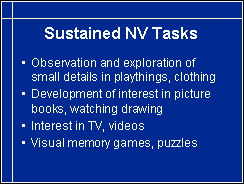
Sustained near vision tasks are usually best assessed at low vision clinics. Since the low vision team members themselves appreciate reading, prerequisites for reading and writing are evaluated and trained from early on. Before visual acuity and contrast sensitivity can be measured, teachers and therapists can observe which are the smallest details that the infant/child notices in clothing and in playthings. When picture books can be used, we can discuss details in pictures. However, we should not think that a child, who notices details in pictures, sees them like a normally sighted child. If it looks like that the child memorises the structure of pictures, it is now a days easy to scan the pictures and to change colours of the details that the child can "recognise". It is namely often a colour blob that the child has learned to notice and knows that other people call it by a specific name.
Perception of pictures is one of the most difficult higher visual functions for many visually impaired children. Picture perception can be trained by drawing for the child before (s)he can draw him/herself. All visual games and many puzzles can be used in training of several higher visual functions.
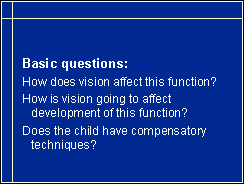
After the four main functional areas have been discussed, parents and teachers may have other specific problems, which may require further assessment and observations. In all problem areas we have the same vision related questions:
- first, how does impaired vision affect this function?
- second, how is it going to affect further development of this function?
- third, if vision does not convey necessary information for a certain function, does the child know compensatory techniques or who is going to take care of special education of that problematic function?
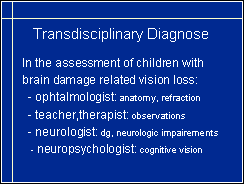
In the assessment of functional vision we need help from all the experts that are involved in the care and teaching of the child:
- ophthalmologists can give basic information on the structure of the eyes and anterior parts of the visual pathways and on the oculomotor functions,
- teachers and therapists make important observations on limitations and strengths of visual functions and train the children so that clinical tests are possible at an early age,
- neurologists and neuropsychologists assess the higher visual functions and other neurologic impairments. However, it is important to inform them on the limitations caused by poor image quality because many neuropsychologic tests are designed for children with normal vision and normal visual experiences.
The word "transdisciplinary" means that we work more closely than in interdisciplinary way. We dare and are able to use tests and test situations usually used by other specialists so that tests can be performed when the child is in the mood and in a condition that makes testing possible. Nobody feels being offended when his/her tests have been used by a person with other profession/ocupation, but helps in the interpretation of the results.
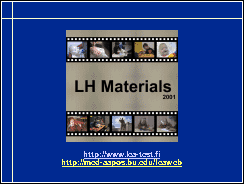
Because so many test situations are difficult to analyse, use of video recording is often the only way to record the findings so that they can be analysed in the low vision team. Video sequences that we have seen during this lecture are all from regular observation videos of different visually impaired children. Internet does not yet have the capacity to show video films of good quality. Therefore a number of videos are now available for teaching programs on my teaching CD "LH Materials 2001".

During the last ten years, paediatric low vision has undergone major changes. We have become aware of visual impairment of children with hearing, motor and intellectual impairments and learned to test them better than before. In western countries more than 70% of visually impaired children have at least one other impairment and many children have several impairments or choric illnesses. Since the very small premature infants now survive we are getting a new population of children with loss of brain damage related higher visual functions.
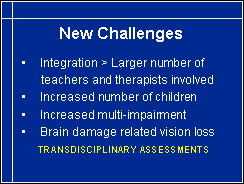
The assessments have become so time consuming and difficult that the transdisciplinary approach is the only way to do a comprehensive evaluation of all functions.
I would like to close by demonstrating a challenging child.
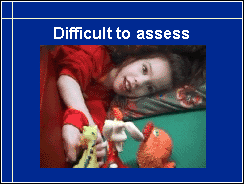
In the still picture she seems to look at the camera relaxed and happy. The video, however, shows another reality. This child has severe motor problems with constant spasms in the neck musculature and ocular muscles, both extraocular and intraocular muscles. During the spasms the eyes deviate up, there is strong convergence movement and accommodation so that during the spasm the child is 10 to 15 diopters nearsighted. Most of these children cannot talk so in all areas of functioning they are "prisoners of their body". At present we do not have good clinical evaluations for these children who are most in need of comprehensive assessment. Despite the development in examination techniques and tests, we still have plenty to learn to develop our work so that we can serve ALL children.
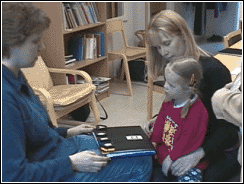
When working together, medical experts together with educational experts and therapists, this will be possible. I started my morning lecture with this short video sequence depicting co-operation of a kindergarten teacher and an ophthalmologist in measurement of visual acuity. We have very good experiences of transdisciplinary work in low vision in many countries, so we can hope that it will become the routine approach in the years to come. Thank you for your attendance.